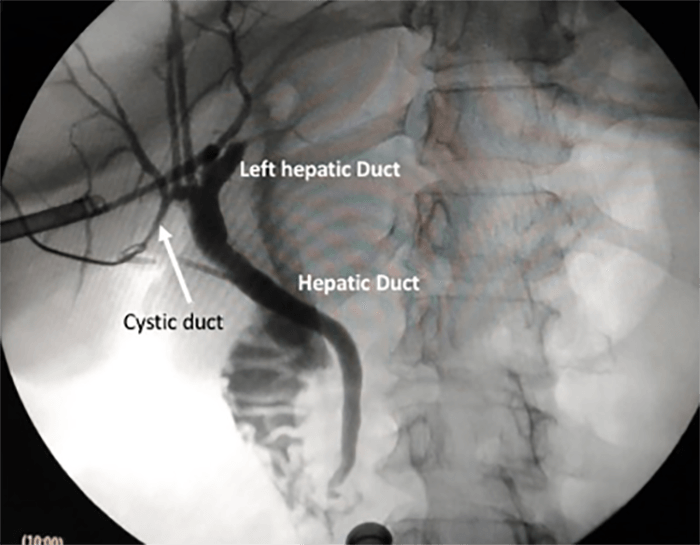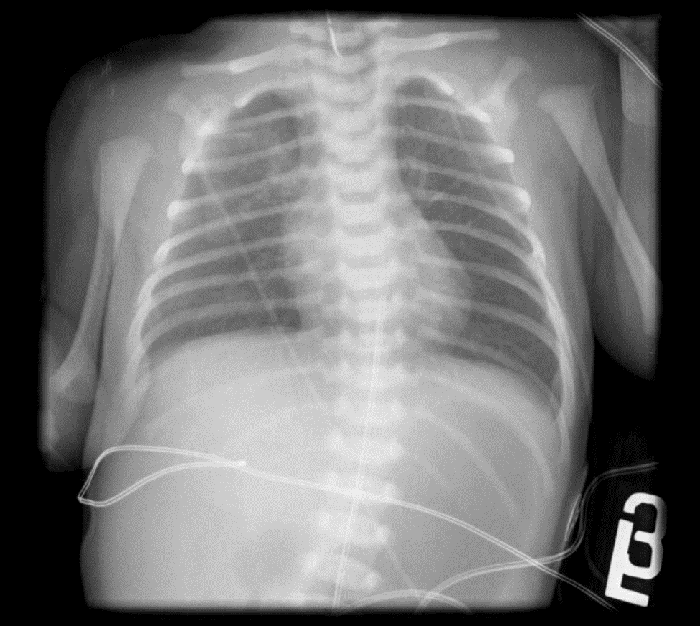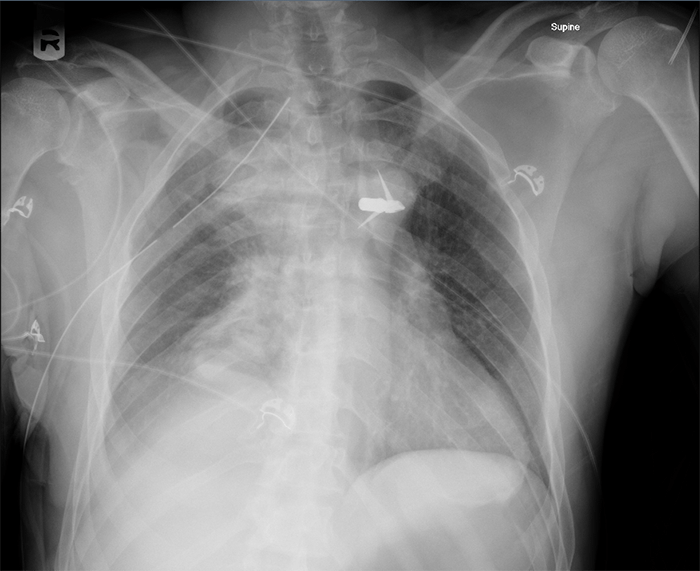Discussion
Hepatic cystic lesions represent a broad spectrum of disease entities, many of which may follow a benign course and remain asymptomatic.1 Less than 5 percent of all cystic lesions of the liver are cystic neoplasms.2 However, it is critical to be able to discriminate between benign and neoplastic cysts that may require specific treatment.
Cholangiocarcinoma (CCA) is a rare malignancy arising from the epithelial cells of the bile ducts, and accounts for approximately 10–25 percent of all liver cancers.3 CCAs are subdivided as intrahepatic, perihilar, or extrahepatic, which vary in clinical presentation, differential diagnosis, and prognosis. Intrahepatic cholangiocarcinoma (IHCC) represent approximately 20 percent of all cholangiocarcinomas,4 and have had an increasing incidence and mortality in recent decades.5 Curative resection remains the only effective treatment modality for CCA. The median survival of patients with IHCC who undergo surgery is six months, while the five-year survival for patients with IHCC who undergo resection is only 20–40 percent.3
Diagnostic evaluation includes a combination of imaging, endoscopy, cholangiography, and serologic tumor markers. While many tumor markers have been evaluated, serum CA19-9 and CEA have emerged as the most studied.3 Elevated serum CA19-9 >37U/mL has been associated with a higher incidence of metastases and poorer prognosis in cholangiocarcinoma, however the sensitivity and specificity for diagnosing IHCC is 62 percent and 63 percent, respectively.6 Additionally, serum CA19-9 may be falsely elevated in benign biliary disease or cholangitis.3 Serum CEA has been associated with several gastrointestinal tract malignancies, including stomach, colon, pancreas, and CCA. In one large series tracking 333 patients with primary sclerosis cholangitis who developed CCA, serum CEA level >5.2 ng/mL was found to have a sensitivity and specificity of 68 percent and 82 percent, respectively.7 However, CEA has also been found to be elevated in nonmalignant conditions, including gastritis, peptic ulcer disease, diverticulitis, diabetes, and other conditions of inflammation.
Tumor markers of aspirated cyst fluid may offer additional insight, however there is a paucity of data on biliary cyst fluid aspiration. In one review of six patients with benign biliary cysts, cystic fluid showed more than 100-fold increase of cystic fluid CA19-9, arguing against its utility for detecting malignancy.8 In a review of 17 consecutive cystic lesions from 15 patients studying cyst fluid CEA, low levels (<5ng/mL) were found in benign, nonmucinous cysts and elevated levels (>600 ng/mL) were found in biliary cystadenomas, cystadenocarcinomas, and pseudocystic metastatic carcinomas, yielding a sensitivity of 100 percent and specificity of 94 percent, suggesting that cystic fluid CEA may help in the detection of malignant cystic liver lesions.9
From the literature on pancreatic cystic lesions, pancreatic cystic fluid CEA and CA19-9 have found to be elevated in malignant cysts.10 The sensitivity and specificity of CEA is 91.8 percent and 63.9 percent and of CA 19-9 were 81.3 percent and 69.4 percent, respectively.10 Cyst fluid CEA has been found to be helpful in discriminating mucinous from nonmucinous pancreatic cysts, but has not been able to aid in the differentiation between premalignant and malignant cysts.11,12 Similarly, low pancreatic cyst CA19-9 levels (<37U/ml) suggest benign lesions, but elevated levels do not distinguish between premalignant and malignant lesions.10
Biliary cytology has a limited role in the diagnosis of CCA. In one study of 97 patients with cholangiocarcinoma, biliary cytology had only a modest sensitivity of 55 percent, with 100 percent specificity.11-13 In a large study of 766 consecutive patients who underwent biliary drainage for obstructive jaundice due to CCA, cytology of the drained bile yielded a sensitivity of 24.7 percent.14 Factors that were found to be associated with a positive bile cytology included perihilar tumor location, tumor extent >20 mm, poorly differentiated grade tumor, and three or more samplings.14 This study did find that the addition of endobiliary forcep biopsy increased sensitivity to 77.9 percent, and therefore biliary cytology may have a role when combined with endobiliary biopsy.14 In our case, we found the cytology of the malignant biliary cystic lesion to be negative, supporting the limited role for biliary cytology alone.
Conclusion
Cholangiocarcinoma remains an aggressive malignancy with a poor prognosis. It is minimally responsive to chemotherapy and radiation, and surgical resection is currently the only effective therapy. CCA is difficult to diagnose, and there is no specific serologic biomarker for detection of CCA.3
Stratifying risk of malignancy in biliary cysts remains difficult, despite advances in non-invasive imaging modalities. Currently, our understanding for the role of biliary cyst aspiration is limited. However, there is data to suggest that cystic fluid CEA, but not CA19-9 may help to stratify the risk of malignancy. This self-controlled study provides a unique support for the value of cystic fluid CEA, but not CA19-9 in differentiating benign versus malignant cysts.
Lessons Learned
Accurate preoperative differentiation of benign versus malignant biliary cysts is challenging. Elevated biliary cyst aspiration CEA, but not CA19-9, may help to stratify high risk biliary cysts that should be resected.
Authors
Gregory I. Lisse, MD, MPH
Virginia Mason Medical Center
Seattle, WA
Adnan A. Alseidi, MD, M.Ed., FACS
Virginia Mason Medical Center
Seattle, WA
Correspondence
Adnan A. Alseidi MD, FACS
Department of Hepatobiliary Surgery
1100 Ninth Ave.
Seattle WA 98101
Phone: 206-341-1908
E-mail: Adnan.Alseidi@virginiamason.org
Meeting Presentations
Seattle Surgical Society
Seattle, WA
February 2018
Disclosures
The authors have no conflicts of interest to disclose.
References
- Choi BY, Nguyen MH. The diagnosis and management of benign hepatic tumors. J Clin Gastroenterol. 2005;39:401–412.
- Del Poggio P, Buonocore M. Cystic tumors of the liver: a practical approach. World J Gastroenterol. 2008 Jun 21;14(23):3616–20.
- Malaguarnera G, Paladina I, Giordano M, Malaguarnera M, Bertino G, Berretta M. Serum markers of intrahepatic cholangiocarcinoma. Dis Markers. 2013;34(4):219–28.
- Saha SK, Zhu AX, Fuchs CS, Brooks GA. Forty-Year Trends in Cholangiocarcinoma Incidence in the U.S.: Intrahepatic Disease on the Rise. Oncologist. 2016 May;21(5):594–9.
- Yamamoto M, Ariizumi S. Surgical outcomes of intrahepatic cholangiocarcinoma. Surg Today. 2011 Jul;41(7):896–902.
- Shen WF, Zhong W, Xu F, et al. Clinicopathological and prognostic analysis of 429 patients with intrahepatic cholangiocarcinoma. World J Gastroenterol. 2009 Dec 21;15(47):5976–82.
- Siqueira E, Schoen RE, Silverman W, et al. Detecting cholangiocarcinoma in patients with primary sclerosing cholangitis. Gastrointest Endosc. 2002 Jul;56(1):40–7.
- Iwase K, Takenaka H, Oshima S, et al. Determination of tumor marker levels in cystic fluid of benign liver cysts. Dig Dis Sci. 1992 Nov;37(11):1648–54.
- Pinto MM, Kaye AD. Fine needle aspiration of cystic liver lesions. Cytologic examination and carcinoembryonic antigen assay of cyst contents. Acta Cytol. 1989 Nov–Dec;33(6):852–6.
- Talar-Wojnarowska R, Pazurek M, Durko L, et al. Pancreatic cyst fluid analysis for differential diagnosis between benign and malignant lesions. Oncol Lett. 2013 Feb;5(2):613–616.
- Park WG, Mascarenhas R, Palaez-Luna M, et al. Diagnostic performance of cyst fluid carcinoembryonic antigen and amylase in histologically confirmed pancreatic cysts. Pancreas. 2011 Jan;40(1):42–5.
- Sawhney MS, Devarajan S, O'Farrel P, et al. Comparison of carcinoembryonic antigen and molecular analysis in pancreatic cyst fluid. Gastrointest Endosc. 2009 May;69(6):1106–10.
- Hattori M, Nagino M, Ebata T, Kato K, Okada K, Shimoyama Y. Prospective study of biliary cytology in suspected perihilar cholangiocarcinoma. Br J Surg. 2011 May;98(5):704–9.
- Kim JY, Choi JH, Kim JH, et al. Clinical usefulness of bile cytology obtained from biliary drainage tube for diagnosing cholangiocarcinoma. Korean J Gastroenterol. 2014 Feb;63(2):107–13.






